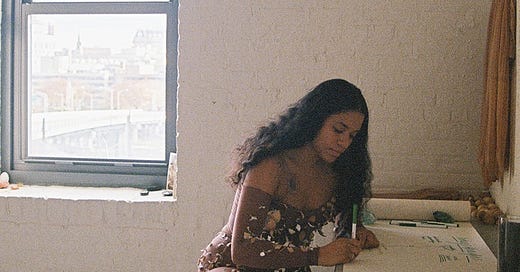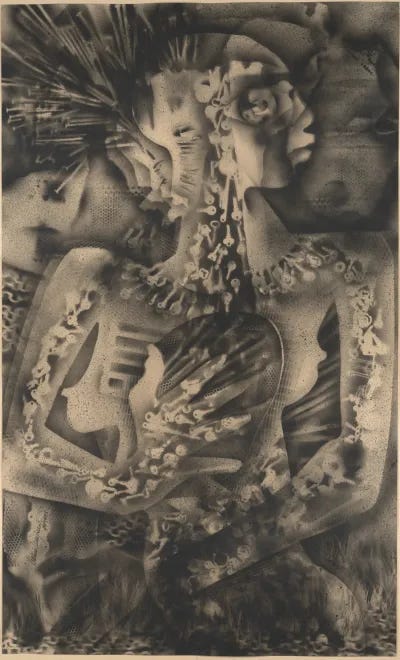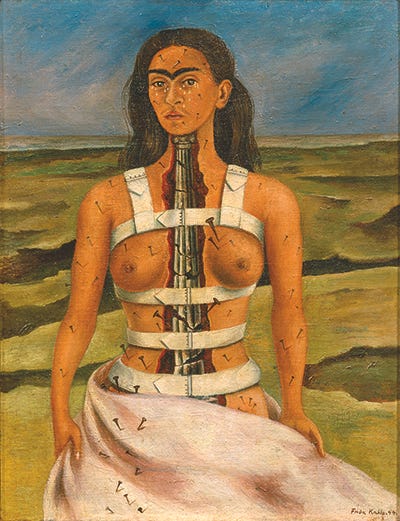It has been 1 year, 11 months, and 15 days since I released the last Artletter. Yes, the exact countdown was essential for dramatic effect. In between there and now, I am now a Master in fine arts (okkkkk). I did a whole thesis on female identity through the lens of daughterhood and interviewed 40 daughters across backgrounds, ages, and the country. I got a billboard in New York City. My first photo essay was published in print. My work was written alongside Senga Nengudi, in print!!! (like whatttttt!) I got a man, lol. My sisters are thriving, growing more and more into themselves. We went to our homeland (The Philippines) for the first time. I’ve picked up Boxing, Bikram yoga, and Qigong. I still teach elementary and middle school students and they frfr still be teaching me. I launched the curatedbyciarra Instagram profile. I made a substack. And most importantly, I went back to the museum and fell in love with art again.
I originally started this Artletter with a few paragraphs on things I don’t like in the art world right now, but I quickly realized, this is the Artletter 2.0. This is Curated by Ciarra, an extension of my art practice and the previous Artletters, where I uplift the artists and the artwork I love.
I have changed. My views have changed, but the one thing that remains the same (dramatic pause) is my love for the arts. In between my last Artletter and now, it has always been clear that I believe in art’s divine power to transform us and the world we live in. As an artist, my responsibility is to create honest work and it is also my responsibility to talk about the artwork that spins in my spirit and the artists who made it. Artists must keep the legacy of other artists alive. Because if not us, who will? Our unique perspective about what other artists did and what they are doing is valuable and holds weight.
After spending the last several months thinking about who I am, what my art practice is, and my place in the world (all light things lol), I am now ready to share my art thoughts again, both short and long, frequent and in between. As always, I hope this Artletter inspires you, makes you think, and gets ya to feel something. There are so many beautiful things that have existed, exist, and will exist in our world. Keep believing, keep sharing, and honor your truth.
And in the words of artist and brilliant thinker Bill Gaskins,
”Pay attention to what gets your attention.”
Toodalo,
Ciarra K. Walters
Art Thoughts on Valerie Maynard and Frida Kahlo
When I saw Valerie Maynard’s “Get Me Another Heart This One's Been Broken Many Times”, I immediately thought of Frida Kahlo's “The Broken Column.”
In Maynard’s piece, there are only two tones, a light brown and various hues of black. It looks like an x-ray of a woman, revealing keys, nails, chains, and other metal-like patterns inside her. Her head and body face various directions as she consoles a male figure, whose head rests on her chest (and hides her heart). At the top, nails shoot out from her head as chains stretch across the bottom. There seem to be shadows lurking around in the background and it looks like she is in a nightmare.
Kahlo’s piece, however, presents a dream-like atmosphere of blue skies and green hills with Kahlo standing front and center. Her hair is neatly tucked behind one ear and she stands tall with her head high, but from the neck down she is sliced open revealing a severely cracked column in place of her spine. A corset the color of bones wraps around her as a light pink fabric swirls around her waist. With nails pinned to her skin, Kahlo stares at us as tears roll down her cheeks.
Even though these two pieces were created 51 years apart, and are night and day to each other, there is a resemblance I could not ignore. Both artists depict a woman’s strength, despite her internal suffering. Kahlo is firm in her pose, even with her teary eyes. Maynard’s figure is surrounded by chaos internally and externally, but she still consoles someone else. Their presence is unshakeable and both works are in conversation with one another.
Now that I’ve described both pieces and highlighted their similarities, I want to further break down each work.
I first saw Maynard’s piece in November at MoMA’s group exhibition, “Vital Signs: Artist and the Body” (up until February 22nd. I went twice, and I highly recommend!).
MoMa included this quote from Maynard in the work’s description, which I feel fits perfectly for this piece.
”You are a composite of everyone who has come before you."
At first glance, one may think that this heartbreak is romantic. But I think “Get Me Another Heart This One’s Been Broken Many Times” reveals that this woman’s heartbreak isn’t solely hers, but the heartbreak of her ancestors. When I look at the keys, they have a motion to them. They flow in her like blood cells, but they also align in her like bones. If we think about Maynard’s quote and look at this work, these keys, to me, represent an inheritance. They are all different shapes and sizes —some old, some new. I think these keys symbolize what she has inherited from her ancestors, showing us that we get more than blood from our families.
The keys also could represent the “keys to life” aka, the “answers to life”. As I thought about that I realized….the answers are already in me and trauma (and blood) isn’t the only thing passed down through my ancestry.
Then a scarier thought popped up:
What parts of my ancestors’ pasts are hidden in me? And if I already have the keys, how do I find the locks?
So many things we could unpack, like what the other metal objects symbolize and why isn’t this woman’s heart present in the work. But I’ll leave that up to you to break down! Love, love, love this work. Ms. Maynard gave me another way of seeing my body and all the magic it is made up of, both the beauty and the pain.
Going into “The Broken Column”, despite the visible pain Kahlo is in, this painting is such a stunning piece. The first thing I noticed was the cracked column in her. Her head is high, propped on a column that looks like it could crumble at any moment. I love this piece because Kahlo makes us aware of the female body (particularly her body) in a new way. She unveils her internal, physical pain.
As many people know, Kahlo was in a fatal bus accident at 18. This left her with lifelong pain, having to undergo several back surgeries, and causing her to be bedridden for large portions of her life. The column being cracked in multiple places shows that her spine is slowly breaking down and obviously, as a result of that she is in immense pain, which we can feel by noticing the nails covering her body.
As I continue to age into my thirties I have noticed that my body is a very different body from my twenties. Things about my body that I used to take for granted (or even complained about), I am acutely aware of now. Since my mother’s diagnosis, I have spent the last six years thinking about how fragile our bodies truly are. What is the physical pain that we deal with daily, or worse, that we go through silently?
Even though this painting could be seen as a little… gruesome? Kahlo exposes us to her pain and the internal pain we feel or eventually will feel, as our bodies age (or if we are in an accident, become sick, etc.). And she does it in such a beautiful way that it’s hard to look away.
“The Broken Column” makes me think about a different kind of heartbreak: the heartbreak we feel over our fragile bodies.
When our columns crack, and the pain follows, how do we cope with our everchanging bodies?
Some Questions to Ask:
Get Me Another Heart This One’s Been Broken Many Times:
~Why did she use those metal objects?
~Why is she consoling that man?
~How did the artist make this work?
~What do the keys say to you?
The Broken Column:
~Why did she choose a column?
~What is the relationship between the body and a building?
~Why did she paint herself in a beautiful landscape instead of a gloomier one?
~What does her posture and facial expression say to you?
Spend some time with both works. They (The National Gallery of Art) call it, “slow looking”. Spot each detail from the top to bottom and from the bottom to top.
This has been so much fun. Please share your thoughts!
There is no wrong way to look at art. The work is always open for interpretation and our minds expand when we talk about our POV :) Thanks for being here. Xx






